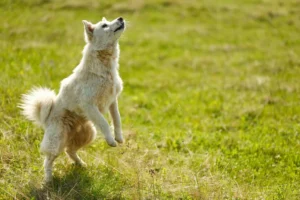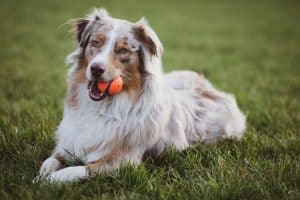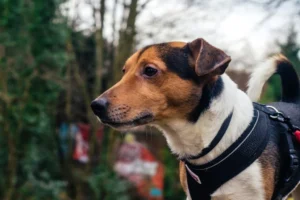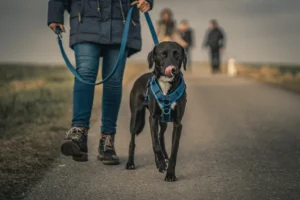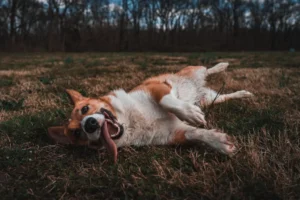Ah, the classic “Roll Over” command—a trick that can elicit a chorus of “awws” from onlookers while showcasing your pup’s obedience skills.
But have you ever found yourself struggling to teach your dog this seemingly simple command, feeling both frustrated and a little envious of those picture-perfect dogs on social media? Don’t worry, I’ve been there too.
Just the other day, I tried teaching my new dog Charlie to roll over, and he ended up sliding across the floor like an uncoordinated seal instead…
But, as it turns out, there’s more to this trick than just the cute factor. My other dog, Sam, knows all about this. So, let’s dive in and learn how to roll our way to a better relationship with our furry friends.

Why Teach Your Dog to Roll Over?
Teaching your dog to roll over is more than just a party trick.
It’s actually an excellent way to engage your dog’s mind and promote a deeper bond between the two of you.
By learning this command, your dog will develop better body awareness and increase their overall confidence.
Plus, it gives you a chance to show off your dog’s skills to friends and family, which can be a fun way to celebrate the time and effort you’ve both invested in training.
In the following sections, we’ll provide you with a step-by-step guide and expert tips to help you and your dog master the “Roll Over” command with ease.
Step-by-Step Guide: Training Your Dog to Roll Over
Step 1: Find the Perfect Environment
Choose a quiet and comfortable environment with minimal distractions for your training sessions. A soft surface like carpet or grass will make it easier for your dog to roll over and feel more comfortable during the process.
Step 2: Warm-Up with Basic Commands
Start by reviewing basic commands like “Sit” and “Down.” Ensuring your dog is comfortable and responsive to these commands will make teaching “Roll Over” much smoother.
Step 3: Use a Treat as a Lure
Hold a treat close to your dog’s nose while they are in the “Down” position. Slowly move the treat from their nose towards their shoulder, leading them to turn their head and follow the treat with their eyes.
Step 4: Guide Your Dog into a Roll
As your dog follows the treat, continue moving it in an arc over their shoulder and towards their opposite hip. This motion should encourage them to roll onto their side and eventually onto their back.
Be patient, as some dogs may require more time to understand the movement.
Step 5: Add the “Roll Over” Command
Once your dog starts to follow the treat and roll over, introduce the verbal command “Roll Over.” Say the command clearly and confidently as your dog begins the rolling motion.
Step 6: Reward and Praise
Immediately after your dog completes the roll, reward them with the treat and offer enthusiastic praise. This positive reinforcement will help them associate the command with the action.
Step 7: Gradual Treat Fading
As your dog becomes more proficient in rolling over, gradually reduce the use of treats as a lure. Instead, use your hand to mimic the treat’s motion and reward your dog intermittently to keep them motivated.
Step 8: Practice and Patience
Consistent practice is crucial for mastering the “Roll Over” command. Be patient, and remember that every dog learns at their own pace. Keep the training sessions short and engaging, and always end on a positive note.
By following these practical and highly useful steps, you’ll soon have your dog rolling over like a pro. Remember, training should be a fun and rewarding experience for both you and your furry friend. Happy training!
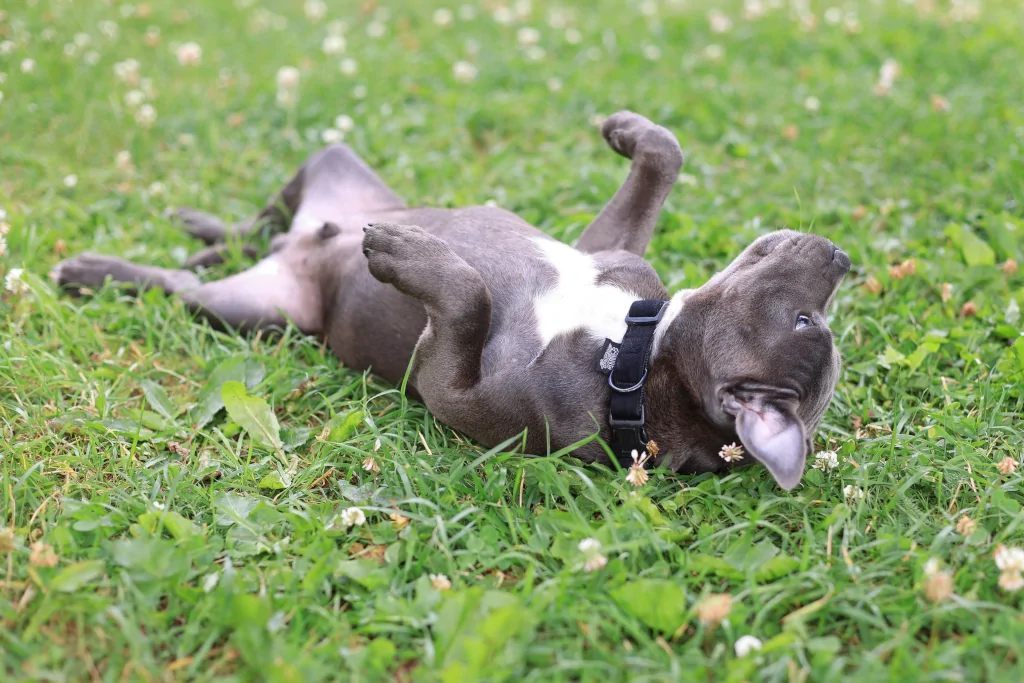
The Importance of Timing and Rewards
You must keep in mind that timing and rewards play a crucial role in your dog’s success. And I’m not just saying that for whatever reason.
Timely rewards help your dog understand which behavior is being praised, while the right reward can motivate and encourage them to perform at their best.
For instance, when I was teaching my dog Sam to roll over, I realized the importance of rewarding him immediately after he completed the roll. Had I waited even a few seconds, he might have associated the reward with a different action. I always made sure to reward him at the right time, and I tried to stay consistent. He can now roll over at any time, without the treats.
Using a variety of rewards can also keep training sessions engaging and fun. While treats are a popular choice, you can also incorporate praise, toys, or playtime as rewards. The key is to find what motivates your dog the most and use that to reinforce their learning.
Read more: How to Choose Training Toys for Your Dog
How Long Does it Take to Master “Roll Over”?
The time it takes for your dog to master the “Roll Over” command varies depending on factors like their age, breed, temperament, and prior training experience.
Some dogs may pick up the trick within a few days, while others might take weeks or even months.
The important thing is to remain patient and consistent with your training sessions.
When I taught Sam to roll over, it took him about two weeks to become comfortable with the command. I noticed that breaking the trick down into smaller steps and practicing for short periods each day helped him learn faster.
Remember, every dog is unique, and comparing your dog’s progress to others may not be helpful or productive. Focus on your dog’s individual journey and celebrate their achievements, no matter how small.
Troubleshooting Tips: Overcoming Obstacles
Encountering obstacles while teaching your dog to roll over is completely normal. Here are some of of them with solutions to help you overcome these common challenges and ensure a successful training experience.
1. Dog struggles to complete the motion
If your dog is struggling with the complete roll over motion, try breaking it down into smaller steps. For example, first teach them to lie on their side and reward them for that. Gradually progress to rolling onto their back, and finally, completing the roll. This approach helped me when Sam was initially hesitant about rolling all the way over.
2. Dog appears physically uncomfortable
Some breeds or older dogs may find it difficult to perform the roll over command due to physical limitations or discomfort. In such cases, consider modifying the trick or choosing a different command that suits their abilities better.
3. Your dog is uninterested in training
If your dog seems uninterested or unresponsive during training, try using high-value rewards, like their favorite treat or toy. This can help keep their attention and motivate them to perform the trick.
4. Distracted dog, doesn’t pay attention
If your dog gets easily distracted, consider shorter training sessions to maintain their focus. Alternatively, if they seem to be losing interest, introduce some variety into the sessions by practicing different commands or incorporating playtime.
5. Progress seems slow or nonexistent
When Sam first started learning to roll over, there were moments when he seemed to forget the trick entirely. In those situations, I reminded myself to stay patient and consistent with our training. Eventually, he gained confidence and mastered the command.
Ways to Keep the Training Fun and Engaging
To ensure your dog stays motivated and enjoys the learning process, it’s essential to keep training sessions fun and engaging.
Mixing up the rewards, introducing new tricks or commands, and incorporating playtime into sessions can help maintain your dog’s interest.
When I was training Sam to roll over, I found that incorporating a game of fetch in between practice attempts helped him stay engaged and excited about the training. You can try the same.
Conclusion: Rolling into a Better Relationship
Teaching your dog to roll over not only results in a fun and impressive trick but also strengthens the bond between you and your furry friend. The time and effort you invest in the training process demonstrate your commitment to their well-being, fostering trust and understanding.
When Sam finally mastered the roll over command, our relationship grew stronger, and I was proud to see him confidently perform the trick whenever asked.
Check our other guides to have your dog learn more tricks, such as to “play dead“, “spin“, and more!
Here’s a great video from Kikopup on teaching your dog to Roll Over:
FAQs
Can I teach “Roll Over” to a large or giant breed dog?
Large and giant breed dogs can learn the “Roll Over” command, but it’s important to ensure they have enough space to perform the trick comfortably and to consider their physical limitations.
What if my dog seems scared or uncomfortable during training?
If your dog appears scared or uncomfortable during training, pause the session, and try to identify the cause. Make necessary adjustments, such as reducing noise or distractions, or the approach, like using a softer tone or different rewards. Always prioritize your dog’s well-being.
Can I use clicker training for teaching “Roll Over”?
Yes, clicker training is an effective method for teaching “Roll Over” as it helps to mark the desired behavior and can be used alongside rewards to reinforce the trick.
Alex, a passionate animal lover, has experience in training and understanding animal behavior. As a proud pet parent to two dogs and three cats, he founded AnimalReport.net to share insights from animal experts and expand his knowledge of the animal kingdom.

